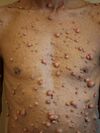Video:Neurofibromatosis
| Neurofibromatosis (Tutorial) | |
|---|---|
| On Commons | |
| Steps for video creation | |
| Step 1 | Preview my changes (10 sec) |
| Step 2 | Upload to Commons (10 min) |
Definition
Neurofibromatosis (NF) is a group of three conditions in which tumors grow in the nervous system.[1] The three types are neurofibromatosis type I, type II, and schwannomatosis.[1]

Presentation
In NF1 symptoms include light brown spots on the skin and colored part of the eye, freckles in the armpit and groin, small bumps within nerves, and scoliosis.[2] In NF2, there may be hearing loss, cataracts at a young age, balance problems, flesh colored skin flaps, and muscle wasting.[2] In schwannomatosis there may be pain either in one location or in wide areas of the body.[3] The tumors in NF are generally non-cancerous.[1]

Cause
The cause is a genetic mutation in certain genes.[1] These can be inherited from a person's parents, or in about half of cases spontaneously occur during early development.[1] Different mutations result in the three types of NF.[4] The tumors involve the supporting cells of the nervous system rather than the neurons.[1] In NF1 the tumors are neurofibromas (tumors of the peripheral nerves), while in NF2 and schwannomatosis tumors of Schwann cells are more common.[1]

Diagnosis
Diagnosis is typically based on symptoms, examination, medical imaging, and biopsy.[5][3] Genetic testing may rarely be done to support the diagnosis.[2]

Management
There is no known prevention or cure.[1][2] Surgery may be done to remove tumors that are causing problems or have become cancerous.[1] Radiation and chemotherapy may also be used if cancer occurs.[1] A cochlear implant or auditory brainstem implant may help some who have hearing loss due to the condition.[1]


Epidemiology
In the United States, about 1 in 3,500 people have NF1 and 1 in 25,000 have NF2.[1] Males and females are affected equally often.[2] In NF1, symptoms are often present at birth or develop before 10 years of age.[1] While the condition typically worsens with time, most people with NF1 have a normal life expectancy.[1] In NF2, symptoms may not become apparent until early adulthood.[1] NF2 increases the risk of early death.[1] Descriptions of the condition occur as far back as the 1st century.[6] It was formally described by Friedrich Daniel von Recklinghausen in 1882, after whom it was previously named.[4]


References
- ↑ 1.00 1.01 1.02 1.03 1.04 1.05 1.06 1.07 1.08 1.09 1.10 1.11 1.12 1.13 1.14 1.15 "Neurofibromatosis Fact Sheet". NINDS. 3 February 2016. Archived from the original on 23 January 2018. Retrieved 16 April 2018.
 This article incorporates text from this source, which is in the public domain.
This article incorporates text from this source, which is in the public domain.
- ↑ 2.0 2.1 2.2 2.3 2.4 "Learning about Neurofibromatosis". National Human Genome Research Institute (NHGRI). 16 August 2016. Archived from the original on 10 October 2016. Retrieved 7 November 2016.
 This article incorporates text from this source, which is in the public domain.
This article incorporates text from this source, which is in the public domain.
- ↑ 3.0 3.1 Dhamija, Radhika; Plotkin, Scott; Asthagiri, Ashok; Messiaen, Ludwine; Babovic-Vuksanovic, Dusica (1993). "Schwannomatosis". GeneReviews®. University of Washington, Seattle. PMID 29517885. Retrieved 21 November 2019.
- ↑ 4.0 4.1 Woodrow, Christopher; Clarke, Anna; Amirfeyz, Rouin (1 June 2015). "Neurofibromatosis". Orthopaedics and Trauma. 29 (3): 206–210. doi:10.1016/j.mporth.2015.02.004. ISSN 1877-1327. Retrieved 22 November 2019.
- ↑ Le, C; Bedocs, PM (January 2019). "Neurofibromatosis". PMID 29083784.
{{cite journal}}: Cite journal requires|journal=(help) - ↑ Evans, Rosalie E. Ferner, Susan M. Huson, D. Gareth R. (2011). Neurofibromatoses in clinical practice. London: Springer. p. 1. ISBN 978-0-85729-628-3. Archived from the original on 10 September 2017. Retrieved 9 October 2015.